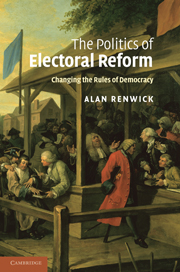Book contents
- Frontmatter
- Contents
- List of tables
- List of figures
- List of abbreviations
- Acknowledgements
- 1 Introduction
- PART I Building blocks
- PART II Elite majority imposition
- 5 France: the recurrent game of electoral reform
- 6 Italy: the search for stability
- 7 Japan: the persistence of SNTV
- 8 Elite majority imposition: comparative analysis
- PART III Elite–mass interaction
- Appendix: glossary of electoral system terminology
- Bibliography
- Index
7 - Japan: the persistence of SNTV
Published online by Cambridge University Press: 04 May 2010
- Frontmatter
- Contents
- List of tables
- List of figures
- List of abbreviations
- Acknowledgements
- 1 Introduction
- PART I Building blocks
- PART II Elite majority imposition
- 5 France: the recurrent game of electoral reform
- 6 Italy: the search for stability
- 7 Japan: the persistence of SNTV
- 8 Elite majority imposition: comparative analysis
- PART III Elite–mass interaction
- Appendix: glossary of electoral system terminology
- Bibliography
- Index
Summary
For most of the five decades following the Second World War, the lower house (House of Representatives) of Japan's Diet was elected using the system of single non-transferable vote (SNTV), under which voters cast a vote for one candidate in a multi-member district, and candidates were elected in order of their vote tallies until all the seats were filled. The reform that abolished this system, enacted after years of debate in 1994, took the form of elite–mass interaction, and is therefore discussed in Part III. In this chapter, I focus on four earlier episodes, summarized in Table 7.1. Reform was achieved in two of these episodes (in 1945 and 1947); in the remaining two (in 1956 and 1973), it was proposed but subsequently abandoned. The last three are all cases of actual or putative reform by elite majority imposition; the first, conducted in the immediate wake of the Second World War and heavily influenced by the Allied occupying powers, involved elite–external interaction. I briefly set the scene by describing the origins of the status quo at the time the first of these episodes occurred.
Japanese electoral reforms, 1889–1945
Japan was not a democracy during the early decades of the twentieth century, but it did have a popularly elected lower house whose approval was required – alongside that of the unelected Privy Council and House of Peers – for all legislation. The lower house was initially elected, from 1889, using single-member plurality (SMP).
- Type
- Chapter
- Information
- The Politics of Electoral ReformChanging the Rules of Democracy, pp. 129 - 137Publisher: Cambridge University PressPrint publication year: 2010



